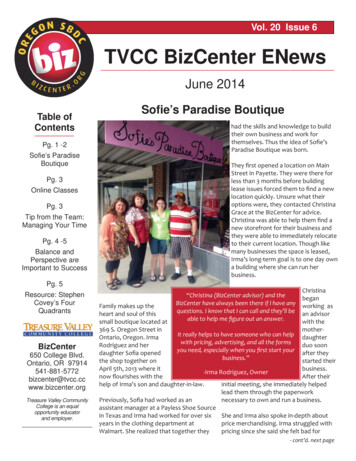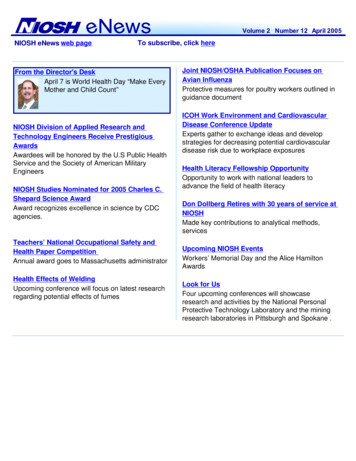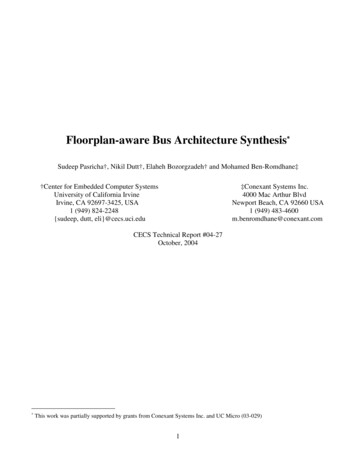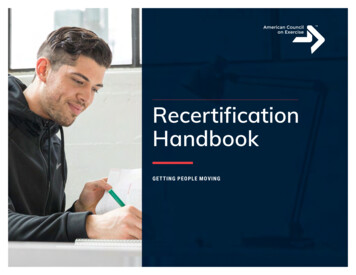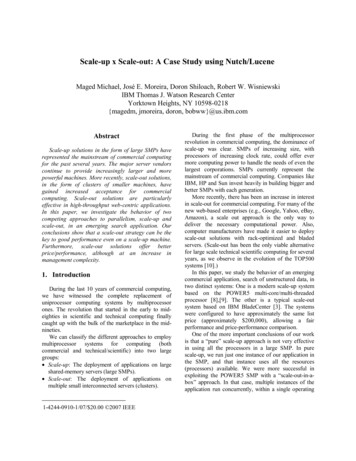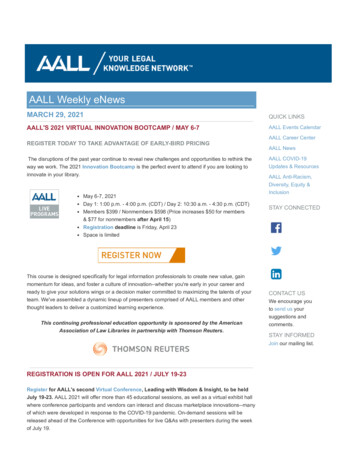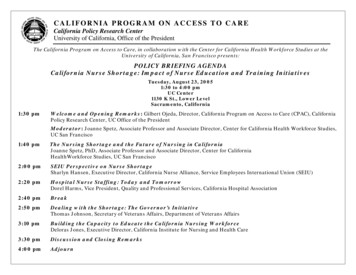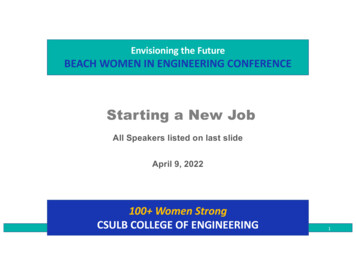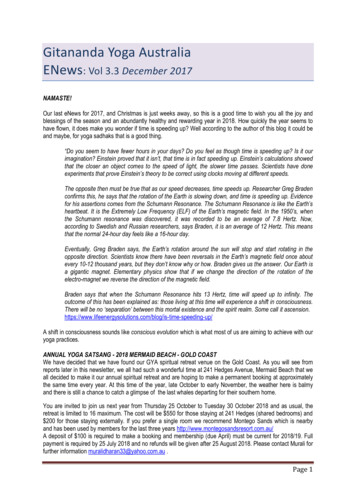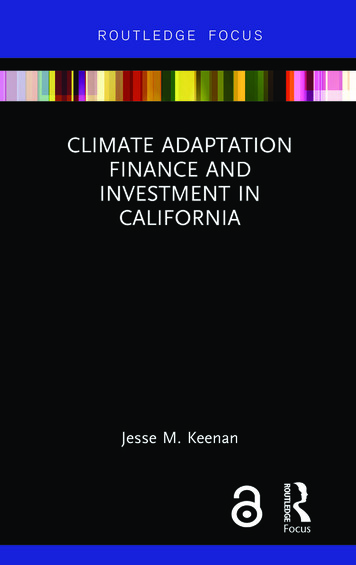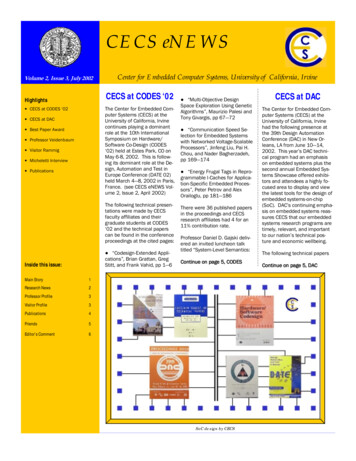
Transcription
CECS eNEWSVolume 2, Issue 3, July 2002Center for Embedded Computer Systems, University of California, IrvineCECS at CODES ‘02HighlightsThe Center for Embedded Computer Systems (CECS) at theUniversity of California, Irvinecontinues playing a dominantrole at the 10th InternationalSymposium on Hardware/Software Co-Design (CODES‘02) held at Estes Park, CO onMay 6-8, 2002. This is following its dominant role at the Design, Automation and Test inEurope Conference (DATE 02)held March 4—8, 2002 in Paris,France. (see CECS eNEWS Volume 2, Issue 2, April 2002) CECS at CODES ‘02 CECS at DAC Best Paper Award Professor Veidenbaum Visitor Rammig Micheletti Interview PublicationsThe following technical presentations were made by CECSfaculty affiliates and theirgraduate students at CODES‘02 and the technical paperscan be found in the conferenceproceedings at the cited pages: “Codesign-Extended Applications”, Brian Grattan, GregStitt, and Frank Vahid, pp 1—6Inside this issue:Main Story1Research News2Professor Profile3Visitor Profile3Publications4Friends5Editor’s Comment6 “Multi-Objective DesignSpace Exploration Using GeneticAlgorithms”, Maurizio Palesi andTony Givargis, pp 67—72 “Communication Speed Selection for Embedded Systemswith Networked Voltage-ScalableProcessors”, Jinfeng Liu, Pai H.Chou, and Nader Bagherzadeh,pp 169—174 “Energy Frugal Tags in Reprogrammable I-Caches for Application-Specific Embedded Processors”, Peter Petrov and AlexOrailoglu, pp 181—186There were 36 published papersin the proceedings and CECSresearch affiliates had 4 for an11% contribution rate.Professor Daniel D. Gajski delivered an invited luncheon talktitled “System-Level Semantics:Continue on page 5, CODESSoC design by CECSCECS at DACThe Center for Embedded Computer Systems (CECS) at theUniversity of California, Irvinehad the following presence atthe 39th Design AutomationConference (DAC) in New Orleans, LA from June 10—14,2002. This year’s DAC technical program had an emphasison embedded systems plus thesecond annual Embedded Systems Showcase offered exhibitors and attendees a highly focused area to display and viewthe latest tools for the design ofembedded systems-on-chip(SoC). DAC’s continuing emphasis on embedded systems reassures CECS that our embeddedsystems research programs aretimely, relevant, and importantto our nation’s technical posture and economic wellbeing.The following technical papersContinue on page 5, DAC
Page 2RESEARCH NEWSCECS eNEWSSeminar AnnouncementBook ReviewBest Paper AwardThe Center for Embedded Computer Systems (CECS) is pleased to announce the2002 Southern California Embedded Systems Seminar to be held on September 10,2002 at the Jazz Semiconductor Auditorium, Newport Beach, CA.Specification and Design Methodology forReal-Time Embedded SystemsAt the recent 39th Design Automation Conference in New Orleans, LA, Professors FadiJ. Kurdahi and Nader Bagherzadeh receivedthe 2002 IEEE Circuits and Systems VLSITransactions Best Paper Award from Professor Josef A. Nossek, President of the IEEECircuits and Systems Society. This awardwas granted for the paper “A Framework forReconfigurable Computing: Task Schedulingand Context Management”, R. Maestre, F. J.Kurdahi, M. Frenandez, R. Hermida, H.Singh, and N. Bagherzadeh, IEEE Transactions on Very Large Scale Integration (VLSI)Systems, Vol. 9, No. 6, December 2001, pp858-873. The recipients received an IEEECertificate and a cash prize. Congratulations Professor Kurdahi and ProfessorBagherzadeh on this IEEE recognition ofyour research activities!The technical program is currently underorganization but will consist of 8 CECS research affiliates making technical presentations, an industrial panel will discuss futureengineering challenges in embedded systems, and the Luncheon Speaker will be Dr.Justin Harlow, Semiconductor ResearchCorporation.Please watch our web site, www.cecs.uci.edu, for detail program information and freeregistration procedures. This should be anexciting day devoted to leading edge designand technology issues associated with embedded systems. We look forward to yourattendance and participation in reviewingour research activities and discussing yourtechnical problems and concerns.ColloquiumThe following colloquia are being held in theCECS Conference Room 127: 2:00 pm, July 24, 2002, “Polychrony forSystem Design”, Jean-Pierre Talpin, INRIAProject ESPRESSO, France 3:00 pm, July 25 and 26, 2002,“Tutorial on Real Time Operating Systems:Basics and Actual Trends”, Dr. Franz J.Rammig, University of Paderborn, GermanyVISIT O UR W EB S ITE!Randall S. JankaKluwer Academic Publishers2002Dr. Randall S. Janka received his PhD fromthe Georgia Institute of Technology in 1999.This book is an update and expansion onhis doctoral dissertation. The foreward tothis book is written by Professor Daniel D.Gajski who was inspirational in motivatingDr. Janka’s research.This technical bookoutlines and comparesthe various Specification and Design Methodologies (SDM). Hethen develops a design methodologytermed MethodologyApplying Generation,Integration, and Continuity (MAGIC) which isan extension of Gajski’s Specify-ExploreRefine (SER) methodology. He concludes bydiscussing a case study applying the MAGICmethodology to the DARPA Rapid prototyping of Application Specific Signal Processors—Synthetic Aperture Radar (RASSP SAR)example.This well written technical book is a comprehensive presentation of the present development status of the Specify and DesignMethodology (SDM).WWW. CECS. UCI. EDUContracts Professor Daniel D. Gajski received a gift to support his system level design forcommunications research program from Conexant Systems, Inc. Newport Beach, CA Professor Rajesh K. Gupta received a 40,000 travel grant from National ScienceFoundation for U.S. - France Cooperative Research projectThis best paper award marks the secondtime in less than five years that faculty affiliated with the Center for Embedded Computer Systems have won the award. Professors Daniel Gajski and Frank Vahid won thisBest Paper Award in 1998 for the paper“SpecSyn: An Environment Supporting theSpecify-Explore-Refine Paradigm for Hardware/Software System Design”, Frank Vahid, Sanjiv Narayan, Jie Gong, and DanielGajski, IEEE Transactions on Very LargeScale Integration (VLSI) Systems, Vol. 6, No.1, March 1998, pp 84-100.“It is most rewarding to see the Center forEmbedded Computer Systems receive international recognition for the outstandingresearch results accomplished by the faculty, students, and research associates,”says Dean Nicolaos G. Alexopoulos of theHenry Samueli School of Engineering.“These two best paper awards are tangibleevidence of the Center’s excellence.”These Best Paper Awards are symbolic recognition of the excellence and quality inresearch performed at the Center for Embedded Computer Systems. Our historicand continuing commitment to leading edgeresearch in embedded systems is a passionthat we continually strive to instill in all ourgraduate students.
Page 3CECS eNEWSPROFILESProfessor ProfileCECS is proud to profile Associate Professor Alexander V. Veidenbaum, Department of Information and Computer Science , University of California, Irvine (UCI), as an outstanding research affiliate.He serves as Director of the Hardware and Systems Laboratory atCECS. Professor Veidenbaum was born in St. Petersburg, Russiaand received a PhD from the University of Illinois at UrbanaChampaign in 1985. He was an Assistant Professor in the Department of Computer Science at the University of Illinois at UrbanaChampaign from 1985 to 1994. He was also a member of the technical staff at the Center for Supercomputing where he was one ofthe principal designers of the Cedar multiprocessor and its successors. From 1994 to 1995 he was the Director of Technology at theInternational Supercomputing Technology in Mulhose, France wherehe led the development of another highly parallel computing systemfunded by the European community. From 1995 to 1998 he was anAssociate Professor at the University of Illinois in Chicago and joinedthe UCI faculty in 1999.Professor Veidenbaum’s research interests are hardware and systems, including building computer systems, computer architecture,and compiler design. He has made significant contributions in theareas of memory hierarchy and cache design, adaptive system architecture, and multiprocessing systems. He recently spent a year inindustry developing systems for optimizing the delivery of IP-baseddata over mobile and cellular networks. (see CECS eNEWS Volume2, Issue 2, April 2002, page 2)Professor Veidenbaum’s current research focuses on designing systems with low energy consumption, for both high-performance andembedded domains, systems for mobile network infrastructure, andhigh-performance architecture.Professor Veidenbaum is the author of more then 40 technical publications in refereed conferences and journals. The following are asample of his recent publications: “Power-Efficient Instruction Fetch Architecture for SuperscalarProcessors”, Ana-Maria Badulescu and Alex Veidenbaum, Proceedings on Parallel and Distributed Processing Techniques and Architectures (DDPTA), June 25-27, 2002 “Adapting Cache Line Size to Application Behavior”, AlexanderV. Veidebaum at el, Proceedings of the International Conference onSupercomputing, June 1999, pp 145-154Visitor ProfileCECS is honored to host for the months of June, July, and August aVisiting Researcher, Professor Franz J. Rammig, Universitaet Paderborn, Germany. He was born in Landsberg/Lech, Bavaria and received his MSc degree in Mathematicsfrom Universitaet Bonn, Germany in1973, and the Dr. rer. nat. degree inInformatics from Universitaet Dortmund, Germany in 1977.Since 1983, Professor Rammig hasbeen a professor for Practical Informatics at University of Paderborn andrecipient of a donated chair at theHeinz Nixdorf Instit, an interdisciplinary research institute concentratingon Informatics, Mechanical Engineering, Electrical Engineering, and Economics. He is currently serving asthe Chairman of the Heinz Nixdorf Instit. Professor Rammig alsoserves as CoDirector of C-LAB which is a collaborative research anddevelopment laboratory between University of Paderborn and Siemens AG. C-LAB has approximately 70 scientists and 120 graduatestudents performing comprehensive research in Distributed Computing. Professor Rammig is also a member of the Board of Directors ofthe Paderborn Center for Parallel Computing, one of Germany’s mostprestigious research institutes in Parallel Computing.In 1998-1999, he served as Vice President of the German Informatics Society. He has been very active in the International Federationfor Information Processing (IFIP) representing Germany and servingon numerous working groups. His efforts were recognized in 1998when he received the IFIP Silver Core Award. Professor Rammig is amember of the Editorial Board of the Journal of Network and Computer Applications and Teubner Texte zur Informatik, a series of German monographs.The research interests of Professor Rammig are focused on the design process for distributed embedded real-time systems. This includes abstract specification methodologies, modeling techniques,synthesis and verification, hardware/software codesign, real-timeoperating systems, and real-time communications systems. He isthe author of over 80 technical publications and the following arethree of his most recent publications: “Customizing the Configuration Process of an Operating SystemUsing Hierarchy and Clustering”, Ramakrishna Cirvukula, CarstenBoeke, and Franz J. Rammig, Proceedings of the 5th IEEE International Symposium on Object-Oriented Real-Time Computing (ISORC2002), April 29—May 1, 2002, pp 280-287 “OCL Goes Real-Time”, Franz J. Rammig, Proceedings of the 5thIEEE International Symposium on Object-Oriented Real-Time Computing (ISORC 2002), April 29—May 1, 2002, pp 423-424Prof. Alex Veidenbaum with the Adaptive Memory Hierarchyboard he designed for a DARPA funded project. “Synthesis Aspects of the PARADISE Design Environment”, FranzJ. Rammig, Proceedings of the 7th IEEE International Workshop onObject-Oriented Real-Time Dependable Systems (WORDS 2002),January 7-9, 2002, pp 27-34
Page 4PUBLICATIONSCECS eNEWSThe following were published by CECS faculty affiliates during the period of April 1, 2002 to June 30, 2002:FocusTitle, Authors, PublicationCoDesign“Codesign-Extended Applications”, Brian Grattan, Greg Stitt, and Frank Vahid, Proceedings of the 10thInternational Symposium on Hardware/Software CoDesign, May 6-8, 2002, pp 1—6Design Space Exploration“Multi-Objective Design Space Exploration Using Genetic Algorithms”, Maurizio Palesi and TonyGivargis, Proceedings of the 10th International Symposium on Hardware/Software CoDesign, May 6-8,2002, pp 67—72Communication Speed SelecSelection“Communication Speed Selection for Embedded Systems with Networked Voltage-Scalable Processors”, Jinfeng Liu, Pai H. Chou, and Nader Bagherzadeh, Proceedings of the 10th International Symposium on Hardware/Software CoDesign, May 6-8, 2002, pp 169—174Reprogrammable Caches“Energy Frugal Tags in Reprogrammable I-Caches for Application-Specific Embedded Processors”, Peter Petrov and Alex Orailoglu, Proceedings of the 10th International Symposium on Hardware/Software CoDesign, May 6-8, 2002, pp 181—186Memory Profiler“A Fast On-Chip Profiler Memory”, Roman Lysecky, Susan Cotterell and Frank Vahid, Proceedings ofthe 39th Design Automation Conference, June 10-14, 2002, pp 332—337HighHigh-Level Synthesis“Coordinated Transformations for High-Level Synthesis of High Performance Microprocessor Blocks”,Sumit Gupta, Timothy Kam, Shai Rotem, Nick Savoiu, Nikil Dutt, Rajesh Gupta, and Alex Nicolau,Proceedings of the 39th Design Automation Conference, June 10—14, 2002, pp 875—881System Level Design“System Level Design Using SpecC Profiler”, Lukai Cai and Daniel Gajski, UCI CECS Technical Report02-08, April 1, 2002Matrix Multiplication“RTL Design and Synthesis of Sequential Matrix Multiplication”, Pei Zhang and Daniel Gajski, UCICECS Technical Report 02-09, April 3, 2002SchedulingScheduling“Scheduling in RTL Design Methodology”, Dongwan Shin and Daniel Gajski, UCI CECS Technical Report 02-11, April 11, 2002Queue Generation“Queue Generation Algorithm for Interface Synthesis”, Dongwan Shin and Daniel Gajski, UCI CECSTechnical Report 02-12, April 11, 2002Interface Synthesis“Interface Synthesis from Protocol Specification”, Dongwan Shin and Daniel Gajski, UCI CECS Technical Report 02-13, April 11, 2002Model Refinement“Automatic Model Refinement for Fast Architecture Exploration”, Junyu Peng, Samar Abdi, and DanielGajski, UCI CECS Technical Report 02-14, April 1, 2002System Design“Interactive System Design Flow”, Junyu Peng, Lukai Cai, Andreas Gerstlauer and Daniel Gajski, UCICECS Technical Report 02-15, April 1, 2002Modeling Guidelines“SpecC Modeling Guidelines”, Andreas Gerstlauer, UCI CECS Technical Report 02-16, April 16, 2002Parallelization OptimizationOptimization“Parallelization Optimization of System-Level Specification”, Lukai Cai and Daniel Gajski, UCI CECSTechnical Report 02-18, June 1, 2002Memory Exploration“A Framework for Memory Subsystem Exploration”, Prabhat Mishra, Mahesh Mamidipaka, and NikilDutt, UCI CECS Technical Report 02-19, May 24, 2002Specification Tuning“Specification Tuning of System Level Design”, Lukai Cai and Daniel Gajski, UCI CECS Technical Report 02-20, June 6, 2002Task Scheduling“Energy Aware Task Scheduling with Task Synchronization for Embedded Real Time Systems”, Ravindra Jejurikar and Rajesh Gupta, UCI CECS Technical Report 02-21, June 21, 2002
Page 5Page 5FRIENDSInterviewOn July 2, 2002, CECS eNEWShad the privilege to interviewDr. Frank Micheletti, Manager,External Technologies Development, Conexant Systems, Inc.,Newport Beach, CA. The discussion ranged over a broadspectrum of business andtechnical issues: student internships, technology transfercooperation, collaborative research paradigms, intellectualproperty, and future technology thrusts and challenges.The following is an extractionof relevant comments he madeduring the CECS interview: eNEWS: What is your perspective of future embedded systems with regard to communications applications? Micheletti: The level of functional integration and feature enhancements in ourproducts will continue to increase which willexacerbate the embedded software contentof future embedded systems. This demandfor new features and emerging standardscontinues the trend of stressing the software content of product design. Futurehand held products will containembedded videofeatures whichwill impactpower requirements and packaging. eNEWS: Whatare Conexant’santicipated future engineeringthrusts?Continue from page 1, DACWhat is needed and what is not needed?”were made by CECS faculty affiliates andtheir graduate students with the citedpages from the conference proceedings:CECS’s influence will continue next year atCODES ‘03 as Professor Rajesh Gupta willserve as Conference General Co-Chair andProfessor Pai Chou will serve as ProgramCo-Chair.CECS is extremely proud of its technicalinfluence at CODES ‘02 and DATE ‘02which reflects the level of technical relevance and recognition in its collaborativeresearch programs.our belief that video will be a large part ofthe personal communications devices inthe next decade, both wireline and wireless. eNEWS: What is Conexant’s desired relationship with CECS? Micheletti: We, of course, are alwayslooking for outstanding new employees andwould like to continue expanding studentintern programs and technology exchangeswith CECS. Further, we would like to develop more collaborative research programs to validate the emerging systemlevel design tools developed at CECS onreal industrial applications. Micheletti:We plan to continue the development of multichip subsystems to supportsystem-in-package (SiP) technology. It isanticipated that these new concepts will bebased on the foundations employed in present Conexant SiP subsystem technologyand methodology. Another important futurethrust will be in home networking applications supporting smart appliances and interactive entertainment systems. Finally,our recent acquisition of Globespan Virata’svideo compression business is based onContinue from page 1, CODESProfessor Rajesh Gupta served as ProgramCo-Chair and Professors Pai Chou, DanielGajski, Rajesh Gupta, Alex Orailoglu, andFrank Vahid served on the Technical Program Committee. This 12% level of participation in conference organization is veryhigh for one research entity.CECS eNEWS “A Fast On-Chip Profiler Memory”, Roman Lysecky, Susan Cotterell and FrankVahid, pp 332-337 “Coordinated Transformations for HighLevel Synthesis of High PerformanceBlocks”, Sumit Gupta, Timothy Kam, Michael Kishinevsky, Shai Rotem, Nick Savoiu,Nikil Dutt, Rajesh Gupta and Alex Nicolau,pp 875—881Professor Nikil Dutt served as Chair of thetechnical session titled “Memory Management and Address Optimization in Embedded Systems” and Professor Rajesh Guptaserved as Chair of the technical sessiontitled “Theoretical Foundations of Embedded System Design”. Professor Frank Vahidserved as an Organizer and Presenter at atutorial titled “New Computing Platforms forEmbedded Systems”. eNEWS: What technology role does Conexant expect CECS to play in the future? Micheletti: We would like to see improvements in predictive hardware/software exploration and optimization techniques to allow better trade-offs in the initial stages of the design process. And, ofcourse, we always hope to see CECS continue to develop innovative design methodologies to increase designer productivity.Although the present relationship is primarily with Conexant Systems, I would like tosee the CECS relationship expanded in thefuture to include Mindspeed Technologyand Skyworks Solutions.Interview conducted by Bob LarsenVisit our site at www.cecs.uci.edu
CECS—Solving Tomorrow’s Problems!Center for Embedded Computer Systems, University of California, IrvineCenter for Embedded Computer Systems, University of California, IrvineCECS Mission Statement:To conduct leading-edge interdisciplinary research in embedded systems, emphasizingautomotive, communications, and medical applications, and to promote technology andknowledge transfer for the benefit of the individual and society.CECS Research Advisory BoardDr. Gilbert F. Amelio, Senior PartnerSienna Ventures, Sausalito, CAPrimary Contact:Robert P. LarsenCenter for Embedded Computer SystemsUniversity of California, IrvineIrvine, CA 92697-3425Phone: 949-824-2960Fax: 949-824-8919Email: larsen@cecs.uci.eduthe concept of spying have any rolein the creative SoC design process?Design SpiesSince September 11, 2001, I havebeen intrigued with the concept ofspying. Could our spying networkhave prevented this horrendousnational tragedy? The signals werethere, but nobody in any policeagency could suppress all the surrounding noise and detect the terrorist’s plans. The intrigue of spying has been the subject of numerous novels and movies.Recently I was reading aboutAtrenta’s SpyGlass 3.0 tool. SpyGlass 3.0 provides customizationof the analysis function so the designer can add rules, enable anddisable tests, and establish profiles that store selection policies,rules, and parameters. The designer can choose among variouspolicy and rule sets that are organized by functional and performance requirements, by applicationselection, and vendor-specificrules.SpyGlass 3.0 also performs testability analysis at the RTL level andincludes rules for automatic testpattern generation and built-in-selftest. By writing RTL code that complies with testability rules, the designer can save considerable synthesis and simulation time whileSpying is defined by Webster’s as:producing functional blocks thatto watch closely and secretly. Does are easier to reuse.The concept of design spyingsounds intriguing while providingan opportunity for increasing designer productivity, design quality,and time-to-market. By employingrules and policies, design spyingcan be made adaptable to any application and design level. Designspying can also improve the learning curve for novice designers.Spy engines could be created toconcurrently or periodically checkfor design violations at the behavioral, structural, and physical levelsof design. The use of design spying would catch design violationsearly; thus making corrective action much less painful and moreeconomical.I believe rule, profile, and policybased design spying could haveprofound cost/time impact on theSoC design and test process!Bob Larsen
Foundation for U.S. - France Cooperative Research project VISIT OUR WEB SITE! WWW.CECS.UCI.EDU Colloquium The following colloquia are being held in the CECS Conference Room 127: 2:00 pm, July 24, 2002, "Polychrony for System Design", Jean-Pierre Talpin, INRIA Project ESPRESSO, France 3:00 pm, July 25 and 26, 2002,
